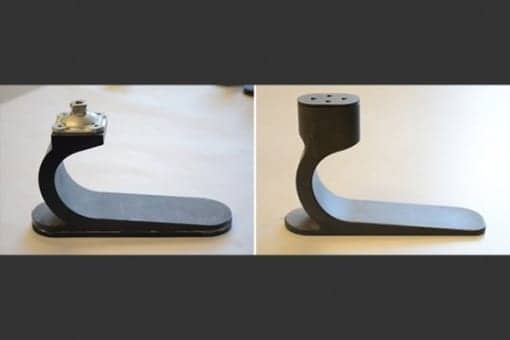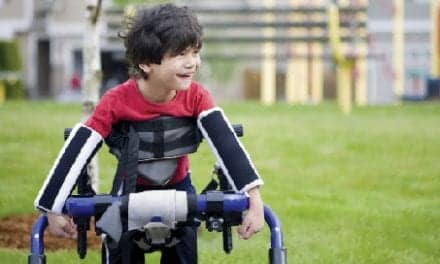
Pictured are two generations of the single-part, low-cost prosthetic foot designed by engineers from Massachusetts Institute of Technology. (Photo courtesy of MIT)
A simple, low-cost, passive prosthetic foot features a shape and stiffness that can be tailored to the individual’s body weight and size to achieve a similar gait to that of an able-bodied person.
The prosthetic foot is custom designed based on a design framework developed by researchers from Massachusetts Institute of Technology.
“[Walking] is something so core to us as humans, and for this segment of the population who have a lower-limb amputation, there’s just no theory for us to say, ‘here’s exactly how we should design the stiffness and geometry of a foot for you, in order for you to walk as you desire,'” says Amos Winter, associate professor of mechanical engineering at MIT, in a media release from MIT. “Now we can do that. And that’s super powerful.”
Winter and former graduate student Kathryn Olesnavage report details of this framework in IEEE’s Transactions on Neural Systems and Rehabilitation. They have published their results on their new prosthetic foot in the ASME Journal of Mechanical Design, with graduate student Victor Prost and research engineer William Brett Johnson, the release explains.
In 2012, Winter was approached by Jaipur Foot—a manufacturer of artificial limbs based in Jaipur, India—to see whether he could design a better, lighter foot that could be mass-produced at low cost.
The team, led by Olesnavage, first looked for a way to quantitatively relate a prosthesis’ mechanical characteristics to a user’s walking performance. Their approach was based on the realization that amputees who have lost a limb below the knee cannot feel what a prosthetic foot does.
Instead of designing a prosthetic foot to replicate the motions of an able-bodied foot, they looked to design a prosthetic foot that would produce lower-leg motions similar to those of an able-bodied person’s lower leg as they walk, the release continues.
The team developed a mathematical model of a simple, passive prosthetic foot, which describes the stiffness, possible motion, and shape of the foot. They then plugged into the model the ground reaction forces from the dataset, which they could sum up to predict how a user’s lower leg would translate through a single step.
With their model, they then tuned the stiffness and geometry of the simulated prosthetic foot to produce a lower-leg trajectory that was close to the able-bodied swing—a measure they consider to be a minimal “lower leg trajectory error.”
“Ideally, we would tune the stiffness and geometry of the foot perfectly so we exactly replicate the motion of the lower leg,” Winter says. “Overall, we saw that we can get pretty darn close to able-bodied motion and loading, with a passive structure.”
The team then sought to identify an ideal shape for a single-part prosthetic foot that would be simple and affordable to manufacture, while still producing a leg trajectory very similar to that of able-bodied walkers.
To pinpoint an ideal foot shape, the group ran a “genetic algorithm”—a common technique used to weed out unfavorable options, in search of the most optimal designs.
Those that had a lower error, the researchers further mixed and matched with other shapes, to evolve the population toward an ideal shape, with the lowest possible lower leg trajectory error. The team used a wide Bezier curve to describe the shape of the foot using only a few select variables, which were easy to vary in the genetic algorithm. The resulting foot shape looked similar to the side-view of a toboggan.
Olesnavage and Winter figured that, by tuning the stiffness and shape of this Bezier curve to a person’s body weight and size, the team should be able to produce a prosthetic foot that generates leg motions similar to able-bodied walking. To test this idea, the researchers produced several feet for volunteers in India. The prostheses were made from machined nylon, a material chosen for its energy-storage capability.
“What’s cool is, this behaves nothing like an able-bodied foot — there’s no ankle or metatarsal joint—it’s just one big structure, and all we care about is how the lower leg is moving through space,” Winter says, in the release. “Most of the testing was done indoors, but one guy ran outside, he liked it so much. It puts a spring in your step.”
Going forward, the team has partnered with Vibram, an Italian company that manufactures rubber outsoles—flexible hiking boots and running shoes that look like feet. The company is designing a life-like covering for the team’s prosthesis that will also give the foot some traction over muddy or slippery surfaces. The researchers plan to test the prosthetics and coverings on volunteers in India this spring.
[Source(s): Massachusetts Institute of Technology, Science Daily]




